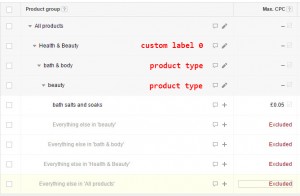Google Shopping Custom Labels for Google Ads is a helpful attribute that allows you to define your campaigns at a much higher level. It lets you create different asset groups (Performance Max) or ad groups (Standard Shopping).
For example, in Performance Max, you can define asset groups based on ROAS, margins, seasonality, performance, etc.
Using Custom Labels
You can use five custom label levels for your specific targeting requirements. For example, you can create segments as follows:
| Custom Label | Group Intent | Possible Values |
| custom_label_0 | ROAS | 5,6,8,10 |
| custom_label_1 | Season | winter,summer,spring |
| custom_label_2 | Brand | nike,adidas |
| custom_label_3 | Top Performing | yes,no |
| custom_label_4 | Clearance | yes,no |
To provide examples, we will use Performance Max.
Then, using the above groups, you can create 1 PMax campaign for each ROAS target, i.e. one campaign for 500% ROAS, one for 600%, etc
You will notice that I also added a brand; usually, the brand attribute could be used, but in some cases, the value is empty due to the absence of valid barcodes. So, adding a brand to the custom label allows you to add a new asset group for each brand, allowing you to create particular asset group headlines, descriptions, images, etc, per brand.
You can even go deeper and create a campaign for top-performing products vs. non-performing ones.
So, the possibilities are endless.
Benefits
- Availability
Let’s say some products have a lot of stock; you should set up a performance max campaign with a more aggressive bidding strategy vs. products that have low stock.
- Margins
You might want to not bid at all for low-margin products, allowing you to only set a campaign targeting high margins
- Clearance
Some merchants may only have limited stock available and would like to list them at half the ROAS target.
- Promotions
Setting up specific ad assets, such as headlines, descriptions, and images, for promotions allows you to have more relevant assets, increasing the performance of your promotions.
- Performance
Sometimes, certain products don’t get any performance, and you should test in a separate campaign if these products truly don’t work or if it’s Google not giving these products a chance to get impressions—a great way to eliminate not knowing if the product is performing poorly.
- Season
Having specific seasonal products in a unique campaign allows you to create particular ad assets. Allowing you to have more relevant headlines, descriptions, and images.
- Brands
In some cases, you can not use the brand attribute due to missing barcodes, so having a custom label with your brand values allows you to set up specific campaigns or add assets per brand.
Additional Benefits
- When using categories, you always have to start at the first level of the tree. For example if we use the taxonomy “Food, Beverages & Tobacco > Food Items > Candy & Gum > Candy & Chocolate > Candy Bars & Pieces”. We would only be able to start from “Food, Beverages & Tobacco”
- However, when we use Custom Labels, we can start at any of the five levels. This allows us to ignore the first level and start at Food Items.

How To Create Custom Labels?
- Using the Feed Rules
- You can create feed rules on any data feed solution.
- With Supplement Feeds
- When using a text delimiter you will need to add a column with the column header being
| Item ID | custom label 0 | custom label 1 | custom label 2 | custom label 3 | custom label 4 |
| item #1 | Winter | BestSeller | LowMargin | ||
| item #2 | Summer | HighMargin | 2013 | ||
| item #3 | Clearance | 2012 |
- Data Feed Application
- You can also add custom labels at source in your data feed application. Each app works differently so best to contact the support team to assist you .
What Are The Limitations?
You are limited to a total of 1000 different values, per custom label group. You can use any other word or sentence in the five custom-label columns. Each unique value in these five columns will be counted as one.
If we look at the table below, we can see that we have nine cells but only six different values. You can have as many values as you like, as long as the total does not exceed 1000 unique values per custom label.
| bedroom | bed | mission |
| bedroom | armoire | amish |
| bedroom | dresser chest | amish |
Here is a guide on how to create product group or asset group subdivisions in Google Ads.